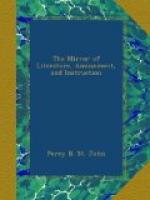Now let us take a retrospective view of this our noble theme, and our interest will be the more strengthened thereon. All the world knows that a convent stood in this neighbourhood, and the present market was the garden, unde Convent Garden; would that all etymologists were as distinct. Of course the monastic institution was abolished in the time of Henry VIII., when he plundered convents and monasteries with as much gusto as boys abolish wasps-nests. After this it was given to Edmund Seymour, Duke of Somerset, brother-in-law to Henry VIII., afterwards the protector of his country, but not of himself for he was beheaded in 1552. The estate then became, by royal grant, the property of the Bedford family; and in the Privy Council Records for March, 1552, is the following entry of the transfer:—“A patent granted to John, Earl of Bedford, of the gifts of the Convent Garden, lying in the parish of St. Martin’s-in-the-Fields, near Charing Cross, with seven acres, called Long Acre, of the yearly value of 6l. 6s. 8d. parcel of the possessions of the late Duke of Somerset, to have to him and his heirs, reserving a tenure to the king’s majesty in socage, and not in capite.” In 1634, Francis, Earl of Bedford, began to clear away the old buildings, and form the present square; and in 1671, a patent was granted for a market, which shows the rapid state of improvement in this neighbourhood, because in the Harleian MSS., No. 5,900, British Museum, is a letter, written in the early part of Charles II., by an observing foreigner to his friend abroad, who notices Bloomsbury, Hungerford, Newport, and other markets, but never hints of the likelihood or prospect of one being established in Covent Garden; yet before Charles’s death the patent was obtained. It is a market, sui generis, confined mostly to vegetables and fruits; and the plan reflects much credit upon the speculative powers of the noble earl who founded it.
Thus far goes the public history; now let us turn to the private memoranda. In 1690, the parish, being very loyal, gave a grand display of fire-works on the happy return of William the Third from Ireland; and in the parish books appear the following entries on the subject, which will give some idea of the moderate charges of parish festivities in those “dark ages.”
“Sept. 23, 1690. L. s. d. Paid to Mr. Brown for 200 ffaggotts and 30 brushes for bonefire for the parish —— 01 02 06
Sept. 25.—Paid Mr. Stockes
for a barrell of ale for bonefire ——
01 00 00
Given to the watchmen to drincke att the king’s returne from Ireland —— 00 02 06
1691.—Given to Stockes and ye watchmen to drincke att the bonefire and fire workes att the king’s returne from Ireland —— 00 10 00
Oct. 12.—Paid the labourers and carters for four dayes’ worke in laying and spreading the gravell —— 01 06 00




